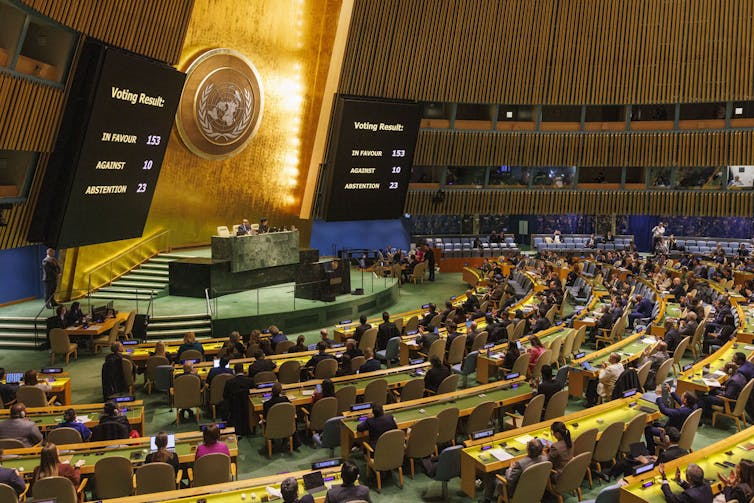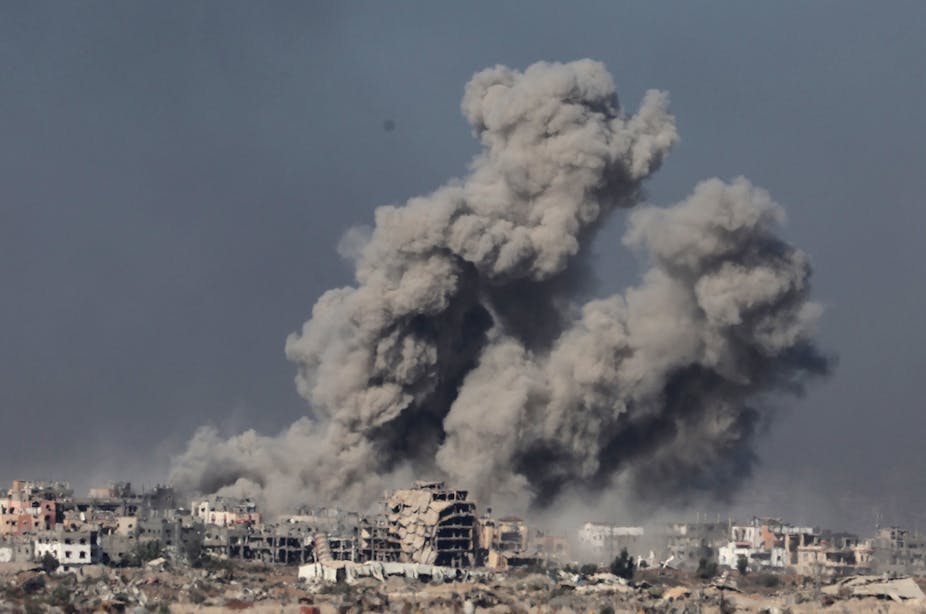As Israel launched its ground offensive in Gaza on October 27 – having conducted airstrikes in the weeks following the horrific attack by Hamas on October 7 – the UN general assembly convened an emergency session. With reports of upwards of 7,000 civilian deaths in Gaza, the general assembly passed a resolution calling for “an immediate, durable and sustained humanitarian truce leading to a cessation of hostilities”.
Meanwhile, the UN security council, which has primary responsibility for international peace and security, remained silent.
By October 27, the security council had voted on four resolutions, all of which had failed. For a resolution to pass, it must receive at least nine affirmative votes and not be vetoed by a permanent member. All five permanent security council members (the P5) – France, China, Russia, the UK and the US – wielded their veto, revealing deep fractures in addressing the crisis.
The first of the four resolutions, proposed by Russia, which came to a vote on October 17, was vetoed by France, the UK and the US. The resolution called for a humanitarian ceasefire but failed to condemn Hamas. The US also objected to the lack of recognition of Israel’s right of self-defence.
A second resolution, proposed by Brazil and voted on October 18 fared better. But it still attracted a US veto due the failure to mention Israel’s right of self-defence.
Billed as a consensus resolution – opting for the more palatable language of “humanitarian pauses” – the disappointment at the US veto was palpable. Brazil remarked: “Council paralysis in the face of a humanitarian catastrophe is not in the interest of the international community.”
A week later, on October 25, the security council met to vote on draft resolutions from the US and Russia. The US resolution, unsurprisingly, focused on the right of self-defence and prompted a double veto by Russia and China.
China, in particular, objected to the inclusion of the “deeply divisive” issue of self-defence and observed that the resolution did not reflect the consensus of the Brazil resolution on addressing the humanitarian situation.
The US vetoed the Russian resolution which, like its predecessor, did not garner sufficient affirmative votes to be adopted. The security council was deadlocked with the US firmly opposed to a humanitarian ceasefire.
Close on the heels of a warning from the UN secretary general, António Guterres, that “Gaza is becoming a graveyard for children”, came the announcement of “tactical, local pauses” for humanitarian aid. And on November 15, Malta successfully tabled a resolution in the security council calling for “urgent and extended humanitarian pauses and corridors”, which was roundly rejected by Israel.
Moreover, a proposed amendment calling for, in the words of the general assembly resolution, “an immediate, durable and sustained humanitarian truce leading to a cessation of hostilities”, was vetoed by the US. Like with Ukraine, the security council had reached the end of the road, stymied by the use of the veto. It would not meet again until prompted to do so by Guterres.
Invoking Article 99
Under Article 99 the secretary general may “bring to the attention” of the security council “any matter which, in in his opinion, may threaten international peace and security”. On December 6, Guterres brought the human suffering wrought by the “hostilities in Gaza and Israel” to the attention of the security council as a matter that “may aggravate existing threats to the maintenance of international peace and security”.
The invocation of Article 99 is significant. As the most powerful tool available to the secretary general, it has only been used six times since 1950. But it does not necessarily prompt security council action. Indeed, under the UN charter, the security council retains discretion as to how, and if at all, to act.
So while the security council met in 1950 to discuss Korea as a result of the then secretary general Trygve Lie bringing the matter to its attention, the subsequent inaction of the security council prompted the general assembly to step in with the “Uniting for Peace” resolution. Invocation of this resolution allows the general assembly to hold emergency sessions when the security council fails “to exercise its primary responsibility” for international peace and security.

When the security council met on December 8, members spoke of a humanitarian imperative for security council action, with a draft UAE resolution demanding “an immediate humanitarian ceasefire” securing 13 affirmative votes. Yet, the US vetoed the resolution. It cited the absence of Israel’s right to self-defence and the lack of condemnation of Hamas and asked why the resolution “fails to encourage a resumption of humanitarian pauses to allow for the release of hostages and an increase in aid”.
Dead end
In response, the general assembly reconvened its October emergency session, held under the 1950 “Uniting for Peace” resolution. The proposed resolution mirrored the UAE resolution that had been vetoed by the US days before in the security council. By a clear majority, the general assembly demanded an “immediate humanitarian ceasefire”.
This time 153 states voted in favour, compared to 120 for the previous resolution. With the number of abstentions dropping by approximately half and a mere ten states voting against the resolution, the global consensus for “an immediate humanitarian ceasefire” was clear.
But Israel was equally clear in holding its position that a ceasefire would not only prolong “death and destruction” but would only benefit Hamas. It was obviously a position shared by the US given its use of the veto. And therein lies the problem.
Yes, there is a global consensus for an immediate humanitarian ceasefire – this is evident in the voting records of both the general assembly and the security council. And yes, the US will be held to account by the general assembly for its use of the veto in the coming days under the “standing mandate” established following the security council impasse over Ukraine.
But there is little more that the UN can do in the face an avowed aversion to ceasefires by Israel – it has now exhausted every avenue available to it to stop the fighting.

